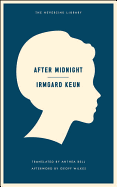
First published in 1937 by German émigrée author Irmgard Keun (1905-1982) as Nach Mitternacht, this slim but important novel portrays the absurd cruelties of the Third Reich via the sardonic observations of a 19-year-old shopgirl who wants to believe in the greater power of love. Susanne "Sanna" Moder begins her account of the day the Führer visits Frankfurt while harboring a letter from her lover between her breasts and wondering what it can mean. She concludes her tale after midnight, by which time she has recounted the permanent distortion of the lives and loves of her social circle and has altered her own fate. After Midnight is saved from hopelessness by Sanna's ability to perceive the changes around her with more mockery than lament. Her wit and youthful outrage serve as a narrative counterpunch to the largely craven atmosphere that surrounds her, yet she is canny enough to avoid public provocation.
Unlike many voice-driven novels, After Midnight captures not just the first-person protagonist's hopes and travails, but also the desires, predicaments and delinquencies of a dozen other characters. As related in Geoff Wilkes's helpful afterword, Irmgard Keun completed After Midnight in exile after the Nazis banned her first two bestselling novels and halted her career by denying her membership in the Reich Literary Chamber. (Keun snuck back into Germany under a false name in 1940, perhaps protected by inaccurate reports of her suicide.) If the original Nach Mitternacht is as lively as Anthea Bell's snappy English translation, Keun was not only a great satirist but also a great stylist. After Midnight is a sharp, vivid and uncompromising read on an impossible subject. --Holloway McCandless, blogger at Litagogo: A Guide to Free Literary Podcasts

